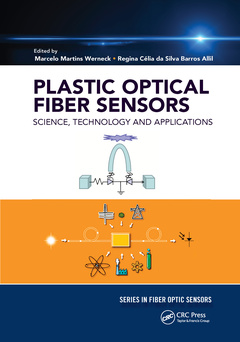Plastic Optical Fiber Sensors Science, Technology and Applications Series in Fiber Optic Sensors Series
Coordonnateurs : Werneck Marcelo M., Allil Regina Célia S. B.

Plastic Optical Fiber Sensors cover the fundamentals and applications of a new class of fiber sensors. With contributions from leading academics in the area, this book covers the theory of plastic optical fiber sensors or (POFs), as well as applications in oil, gas, biotechnology, and energy fields.
Using multiple examples, the editors showcase the advantageous characteristics of POFs, such as ease of handling, large diameter, inexpensive peripheral components and simple termination tools. By doing so, the editors assert that there has been a proliferation of the use of POFs in new consumer products. The book also highlights uses for building various products, such as a POF sensor for oil trucker valve monitoring, a monitoring system for high voltage substation switch, an oil leaking sensor for offshore platforms and a solar tracker for illumination.
Including over 300 black and white images, this book would be highly beneficial for professionals in manufacturing as well as academics in universities, particularly those who use optical fiber sensors on a regular basis.
Contents
Foreword ............................................................................................................ vii
Series Foreword .................................................................................................. ix
Preface ............................................................................................................... xi
Editors ...............................................................................................................xix
Contributors .......................................................................................................xxi
Chapter 1Introduction: Why Plastic Optical Fibers? ........................................ 1
Hui Pan
Chapter 2 Principles of Polymer Optical Fibers ...............................................21
Ricardo Oliveira, Lúcia Bilro, and Rogério N. Nogueira
Chapter 3 Optical Fiber Sensing Principles .....................................................67
Daniel André Pires Duarte, Rogério N. Nogueira, and Lúcia Bilro
Chapter 4 LED-POF-Photodiode as Sensing Elements in high Voltage
Environment ................................................................................. 93
Marcelo Martins Werneck
Chapter 5 Current and Voltage Sensing ........................................................107
Marcelo Martins Werneck
Chapter 6 POF Bragg Gratings ......................................................................131
David Webb
Chapter 7 temperature Sensing by rubi Fluorescence ..................................153
Marcelo Martins Werneck
Chapter 8 Gas Sensing ................................................................................171
Meysam M. Keley
Contents
Chapter 9 Biological Sensing .......................................................................189
Regina Célia da Silva Barros Allil
Chapter 10 POF Displacement Sensors ...........................................................221
Joseba Zubia
Chapter 11 Chemical Sensing with POF ..........................................................251
Filipa Sequeira, Rogério N. Nogueira, and Lúcia Bilro
Chapter 12 POF Sensors for Structural health Monitoring ...............................267
Aleksander Wosniok
Chapter 13 POF and radiation Sensing ......................................................... 285
Pavol Stajanca
Chapter 14 Microstructured POFs ..................................................................313
Maryanne Large and Marcelo Martins Werneck
Chapter 15 POF applications ........................................................................ 353
Marcelo Martins Werneck
Index............................................................................................................... 389
Marcelo Martins Werneck received the Degree in electronic engineering from the Pontifícia Universidade Católica of Rio de Janeiro, in 1975 and his M.Sc. degree from the Biomedical Engineering Program, Federal University of Rio de Janeiro (UFRJ), in 1977. His Ph.D. degree was obtained from the University of Sussex, Brighton, U.K., in 1985. He is the Coordinator of the Instrumentation and Photonics Laboratory at the Electrical Engineering Program, UFRJ. His research interests include fiber optics sensors, nanobiosensors, transducers and instrumentation.
Regina Célia da Silva Barros Allil received her BSc Degree in electronic engineering from the Faculdade Nuno Lisboa, Rio de Janeiro, in 1988, and the M.Sc. degree from the Biomedical Engineering Program, Federal University of Rio de Janeiro (UFRJ), in 2004. Her D.Sc. degree was obtained from the Electrical Engineering Program (UFRJ), in 2010 and the post-doctorate from the Electrical Engineering Program (UFRJ), in 2012. Actually, she is a Visiting Professor of the Instrumentation and Photonics Laboratory, Electrical Engineering Program, UFRJ. Her research interest lies in fiber optics sensors, optoelectronic instrumentation and biosensors.
Date de parution : 06-2022
17.8x25.4 cm
Date de parution : 12-2019
17.8x25.4 cm
Thèmes de Plastic Optical Fiber Sensors :
Mots-clés :
Polymer Optical Fiber; Plastic Scintillation Detectors; POF sensors; Arduino UNO; oil trucker valve monitoring; Air Filling Fraction; oil leaking sensor; Confinement Loss; optical fiber sensing principles; Fiber Bragg Grating Sensors; POFs characteristics; Plastic Optical Fiber; solar tracker; Higher Thermo Optic Coefficients; Bragg Wavelength; FBGs; Microstructured Optical Fibers; LPGs; Optical Fiber Sensor; Step Index Fiber; Refractive Index; Microstructured Fibers; Silica Fibers; Hydrogen Sulfide; Blue Lead; POF Cable; Creepage Distance; Scintillating Fiber; Photonic Bandgap; Evanescent Field; SHM



